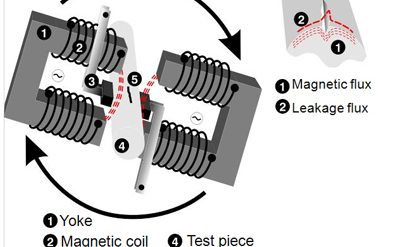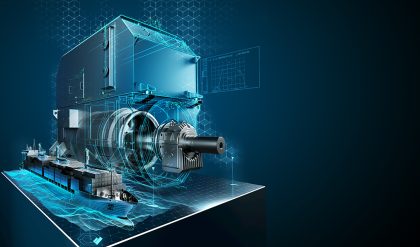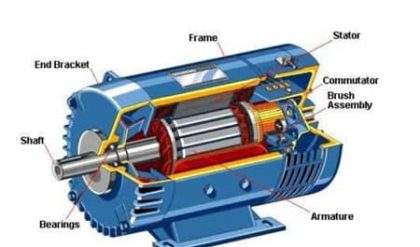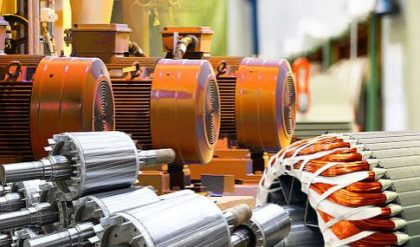Three-phase Transformers are the backbone of electrical power distribution whether Delta or Star connected windings

Thus far we have looked at the construction and operation of the single-phase, two winding voltage transformer which can be used increase or decrease its secondary voltage with respect to the primary supply voltage. But voltage transformers can also be constructed for connection to not only one single phase, but for two-phases, three-phases, six-phases and even elaborate combinations up to 24-phases for some DC rectification transformers. If we take three single-phase transformers and connect their primary windings to each other and their secondary windings to each other in a fixed configuration, we can use the transformers on a three-phase supply. Three-phase, also written as 3-phase or 3φ supplies are used for electrical power generation, transmission, and distribution, as well as for all industrial uses. Three-phase supplies have many electrical advantages over single-phase power and when considering three-phase transformers we have to deal with three alternating voltages and currents differing in phase-time by 120 degrees as shown below.
Three Phase Voltages and Currents

Where: VL is the line-to-line voltage, and VP is the phase-to-neutral voltage.
A transformer can not act as a phase changing device and change single-phase into three-phase or three-phase into single phase. To make the transformer connections compatible with three-phase supplies we need to connect them together in a particular way to form a Three Phase Transformer Configuration.
A three phase transformer or 3φ transformer can be constructed either by connecting together three single-phase transformers, thereby forming a so-called three phase transformer bank, or by using one pre-assembled and balanced three phase transformer which consists of three pairs of single phase windings mounted onto one single laminated core.
The advantages of building a single three phase transformer is that for the same kVA rating it will be smaller, cheaper and lighter than three individual single phase transformers connected together because the copper and iron core are used more effectively. The methods of connecting the primary and secondary windings are the same, whether using just one Three Phase Transformer or three separate Single Phase Transformers. Consider the circuit below:
Three Phase Transformer Connections

The primary and secondary windings of a transformer can be connected in different configuration as shown to meet practically any requirement. In the case of three phase transformer windings, three forms of connection are possible: “star” (wye), “delta” (mesh) and “interconnected-star” (zig-zag). The combinations of the three windings may be with the primary delta-connected and the secondary star-connected, or star-delta, star-star or delta-delta, depending on the transformers use. When transformers are used to provide three or more phases they are generally referred to as a Polyphase Transformer.
Three Phase Transformer Star and Delta Configurations
But what do we mean by “star” (also known as Wye) and “delta” (also known as Mesh) when dealing with three-phase transformer connections. A three phase transformer has three sets of primary and secondary windings. Depending upon how these sets of windings are interconnected, determines whether the connection is a star or delta configuration. The three available voltages, which themselves are each displaced from the other by 120 electrical degrees, not only decided on the type of the electrical connections used on both the primary and secondary sides, but determine the flow of the transformers currents. With three single-phase transformers connected together, the magnetic flux’s in the three transformers differ in phase by 120 time-degrees. With a single the three-phase transformer there are three magnetic flux’s in the core differing in time-phase by 120 degrees.
The standard method for marking three phase transformer windings is to label the three primary windings with capital (upper case) letters A, B and C, used to represent the three individual phases of RED, YELLOW and BLUE. The secondary windings are labelled with small (lower case) letters a, b and c. Each winding has two ends normally labelled 1 and 2so that, for example, the second winding of the primary has ends which will be labelled B1and B2, while the third winding of the secondary will be labelled c1 and c2 as shown.
Transformer Star and Delta Configurations

Symbols are generally used on a three phase transformer to indicate the type or types of connections used with upper case Y for star connected, D for delta connected and Z for interconnected star primary windings, with lower case y, d and z for their respective secondaries. Then, Star-Star would be labelled Yy, Delta-Delta would be labelled Dd and interconnected star to interconnected star would be Zz for the same types of connected transformers.
Transformer Winding Identification
| Connection | Primary Winding | Secondary Winding |
| Delta | D | d |
| Star | Y | y |
| Interconnected | Z | z |
We now know that there are four different ways in which three single-phase transformers may be connected together between their primary and secondary three-phase circuits. These four standard configurations are given as: Delta-Delta (Dd), Star-Star (Yy), Star-Delta (Yd), and Delta-Star (Dy). Transformers for high voltage operation with the star connections has the advantage of reducing the voltage on an individual transformer, reducing the number of turns required and an increase in the size of the conductors, making the coil windings easier and cheaper to insulate than delta transformers. The delta-delta connection nevertheless has one big advantage over the star-delta configuration, in that if one transformer of a group of three should become faulty or disabled, the two remaining ones will continue to deliver three-phase power with a capacity equal to approximately two thirds of the original output from the transformer unit.
Transformer Delta and Delta Connections

In a delta connected ( Dd ) group of transformers, the line voltage, VL is equal to the supply voltage, VL = VS. But the current in each phase winding is given as: 1/√3 × IL of the line current, where IL is the line current. One disadvantage of delta connected three phase transformers is that each transformer must be wound for the full-line voltage, (in our example above 100V) and for 57.7 per cent, line current. The greater number of turns in the winding, together with the insulation between turns, necessitate a larger and more expensive coil than the star connection. Another disadvantage with delta connected three phase transformers is that there is no “neutral” or common connection. In the star-star arrangement ( Yy ), (wye-wye), each transformer has one terminal connected to a common junction, or neutral point with the three remaining ends of the primary windings connected to the three-phase mains supply. The number of turns in a transformer winding for star connection is 57.7 per cent, of that required for delta connection. The star connection requires the use of three transformers, and if any one transformer becomes fault or disabled, the whole group might become disabled. Nevertheless, the star connected three phase transformer is especially convenient and economical in electrical power distributing systems, in that a fourth wire may be connected as a neutral point, ( n ) of the three star connected secondaries as shown.
Transformer Star and Star Connections

The voltage between any line of the three-phase transformer is called the “line voltage”, VL, while the voltage between any line and the neutral point of a star connected transformer is called the “phase voltage”, VP. This phase voltage between the neutral point and any one of the line connections is 1/√3 × VL of the line voltage. Then above, the primary side phase voltage, VP is given as.

The secondary current in each phase of a star-connected group of transformers is the same as that for the line current of the supply, then IL = IS.
Then the relationship between line and phase voltages and currents in a three-phase system can be summarised as:
Three-phase Voltage and Current
| Connection | Phase Voltage | Line Voltage | Phase Current | Line Current |
| Star | VP = VL ÷ √3 | VL = √3 × VP | IP = IL | IL = IP |
| Delta | VP = VL | VL = VP | IP = IL ÷ √3 | IL = √3 × IP |
Where again, VL is the line-to-line voltage, and VP is the phase-to-neutral voltage on either the primary or the secondary side. Other possible connections for three phase transformers are star-delta Yd, where the primary winding is star-connected and the secondary is delta-connected or delta-star Dywith a delta-connected primary and a star-connected secondary. Delta-star connected transformers are widely used in low power distribution with the primary windings providing a three-wire balanced load to the utility company while the secondary windings provide the required 4th-wire neutral or earth connection. When the primary and secondary have different types of winding connections, star or delta, the overall turns ratio of the transformer becomes more complicated. If a three-phase transformer is connected as delta-delta ( Dd ) or star-star ( Yy ) then the transformer could potentially have a 1:1 turns ratio. That is the input and output voltages for the windings are the same. However, if the 3-phase transformer is connected in star–delta, ( Yd ) each star-connected primary winding will receive the phase voltage, VP of the supply, which is equal to 1/√3 × VL.
Then each corresponding secondary winding will then have this same voltage induced in it, and since these windings are delta-connected, the voltage 1/√3 × VL will become the secondary line voltage. Then with a 1:1 turns ratio, a star–delta connected transformer will provide a √3:1 step-down line-voltage ratio.
Then for a star–delta ( Yd ) connected transformer the turns ratio becomes:
Star-Delta Turns Ratio

Likewise, for a delta–star ( Dy ) connected transformer, with a 1:1 turns ratio, the transformer will provide a 1:√3 step-up line-voltage ratio. Then for a delta-star connected transformer the turns ratio becomes:
Delta-Star Turns Ratio

Then for the four basic configurations of a three-phase transformer, we can list the transformers secondary voltages and currents with respect to the primary line voltage, VLand its primary line current IL as shown in the following table.

Where: n equals the transformers “turns ratio” (T.R.) of the number of secondary windings NS, divided by the number of primary windings NP. ( NS/NP ) and VL is the line-to-line voltage with VP being the phase-to-neutral voltage.
Three Phase Transformer Example
The primary winding of a delta-star ( Dy ) connected 50VA transformer is supplied with a 100 volt, 50Hz three-phase supply. If the transformer has 500 turns on the primary and 100 turns on the secondary winding, calculate the secondary side voltages and currents.
Given Data: transformer rating, 50VA, supply voltage, 100v, primary turns 500, secondary turns, 100.

Then the secondary side of the transformer supplies a line voltage, VL of about 35v giving a phase voltage, VP of 20v at 0.834 amperes.
Three Phase Transformer Construction
We have said previously that the three-phase transformer is effectively three interconnected single phase transformers on a single laminated core and considerable savings in cost, size and weight can be achieved by combining the three windings onto a single magnetic circuit as shown.
A three-phase transformer generally has the three magnetic circuits that are interlaced to give a uniform distribution of the dielectric flux between the high and low voltage windings. The exception to this rule is a three-phase shell type transformer. In the shell type of construction, even though the three cores are together, they are non-interlaced.
Three Phase Transformer Construction

The three-limb core-type three-phase transformer is the most common method of three-phase transformer construction allowing the phases to be magnetically linked. Flux of each limb uses the other two limbs for its return path with the three magnetic flux’s in the core generated by the line voltages differing in time-phase by 120 degrees. Thus the flux in the core remains nearly sinusoidal, producing a sinusoidal secondary supply voltage. The shell-type five-limb type three-phase transformer construction is heavier and more expensive to build than the core-type. Five-limb cores are generally used for very large power transformers as they can be made with reduced height. A shell-type transformers core materials, electrical windings, steel enclosure and cooling are much the same as for the larger single-phase types.





